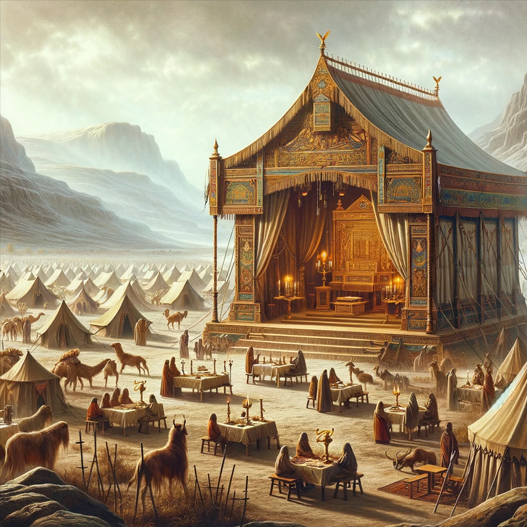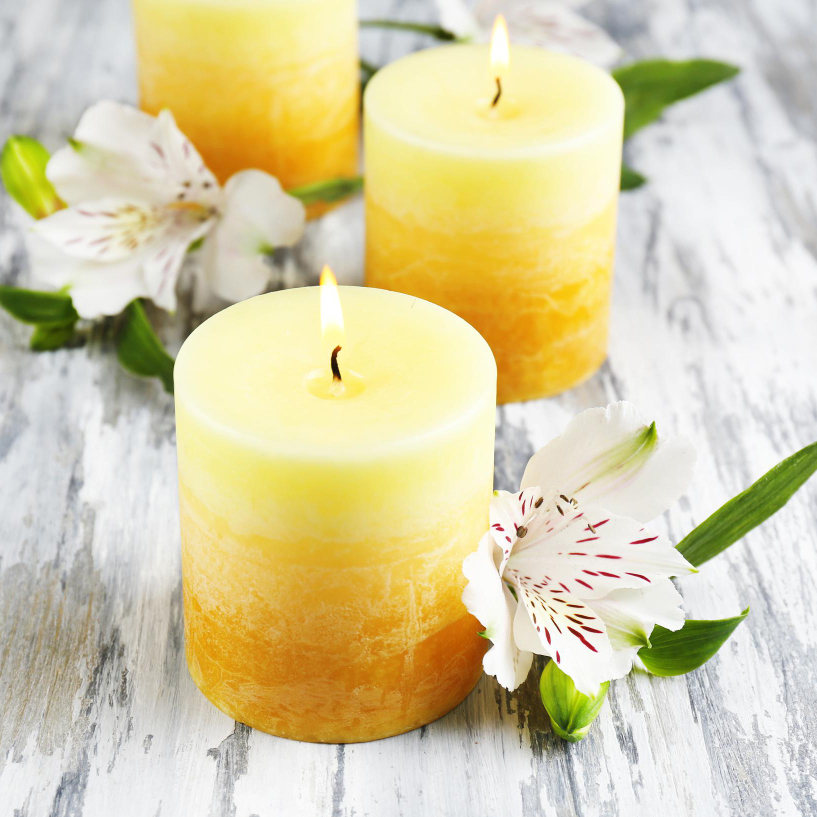Have you ever wondered about the spiritual meanings behind the tabernacle? The tabernacle, described in the Old Testament of the Bible, was a portable sanctuary built by the Israelites during their journey in the wilderness. It served as a physical representation of their relationship with God and held significant symbolic meaning. In this article, we will explore nine spiritual meanings behind the tabernacle’s symbolism, shedding light on its deeper significance and relevance to our spiritual lives today.
1. The Dwelling Place of God
Although the tabernacle and temple held the Ark, they also represented the dwelling place of God. The priests would enter the Holy Place to meet with God. The Holy Place was full of symbols and sacrifices which represented a constant connection with Him. Inside the Most Holy Place sat the Ark of the Covenant. It held three items which were important to the Lord: Aaron’s rod, a pot of manna, and the Ten Commandments.
The Ark of the Covenant is important because it represents our need for God through a mediator. The high priests would go inside to bring blood to offer on behalf of the people. The blood was required as a payment for their sin. It was given as a covering until Jesus, our once-and-for-all sacrifice, came to save us from our sin.
The veil in the temple separated the Most Holy Place from the other sections. When Jesus died on the cross, this veil was torn in two. This symbolized that through His death on the cross, we no longer needed a high priest to offer sacrifices on our behalf because we can come before God ourselves.
1 Corinthians 3:16 says that we are now part of God’s temple and He dwells within us. It’s important for us to have a tabernacle mindset: one that recognizes He is with us at all times.
What do we have within us? A mediator! Jesus Christ is our advocate and one who intercedes for us so we can have direct access to God (1 Timothy 2:5). As part of His living temple, we have direct access to Him when we need it.
When you pray and meditate at Sunday Service, you are welcome in God’s dwelling place every time you lay your burdens at His feet.
Our body represents our own personal tabernacle because we are created in His image. We must recognize this if we want to honor Him!
There are many ways Jesus is your personal tabernacle today. Here is one: since Jesus is also known as Immanuel (God with us), you can find Him when you reenact His birth during Christmas time….
2. God’s Presence in the Midst of His People
Before the Israelites built the tabernacle, God explained that it would be a place where He could meet with them and live with them.
Tabernacle in the Wilderness, David Roberts
When He gave Moses the command to construct the tabernacle in Exodus 25, God said that He was giving instructions “so they may know Me.” This indicates that He wanted to use this structure to reveal Himself to His people.
God is holy. He cannot dwell where there is sin. By creating the tabernacle and giving His people specific instructions to maintain their spiritual cleanliness and approach Him with sacrifices to atone for their sins, He was providing a way for His people to get in touch with Him and receive salvation.
This is a powerful picture. It shows how much God loves and values humanity. In spite of our weaknesses and vulnerabilities, He wants us to have a personal relationship with Him.
The fact that He chose to reveal Himself in this place is mind-blowing. Yet, it brings us back full circle to the garden of Eden. God was with Adam and Eve at all times before they sinned. But when this happened, that same closeness was no longer possible because of sin.
Now, God was building a new sanctuary where His presence could manifest once again. The Bible says God has always been with us in spirit form (cf. John 14:16-17). But the tabernacle was a more physical representation of His presence among His people.
As Christians, we understand that a New Covenant took place through Jesus’ death on the Cross. This was prophesied by Jeremiah (cf. Jeremiah 31:31-34) and it fulfilled many of the Old Testament practices surrounding the tabernacle.
At first glance, building the tabernacle may seem like a pointless exercise. It seems like a massive waste of resources, especially since its construction only lasted less than a year. But when you take into account its spiritual meaning, you realize that it was all worth it.
The tabernacle was created so that humanity could still be close to God, even after Adam and Eve had sinned against Him at the dawn of time.
In this sense, building the tabernacle symbolizes God’s commitment to restoring His relationship with humanity as much as possible without violating free will.
3. The Importance of Sacrifice
At the entrance to the Tabernacle, there was a bronze Alter of Burnt Offering. Here, the Israelites would sacrifice animals to God by fire. An officiating priest would splash the blood of the slain animal against the sides of the Alter, usually as the offerer had placed his hand on the animal’s head. The fire would consume the flesh and transform it into smoke, which floated up to God. It was pleasing to Him and served as a way for man to atone for his sin.
This was a physical representation of man’s need to make restitution for his sin. It was also an acknowledgment of how sinful people can approach a holy God.
When Jesus was crucified, His blood represented the complete and final atonement for sin. He atoned for every man, woman, and child from Adam to the last child born on earth. Hebrews 10:10 tells us, “We have been made holy through the sacrifice of Jesus Christ once for all.”
Jacob Milgrom explained that sacrifices—blood and fat in particular—were “God’s due,” and they allowed man to fulfill his relationship with God. The rendering of these and their consumption by fire were a form of submission and acknowledgment of total dependence on God.
There were different types of offerings in the Mosaic Law: burnt offerings, grain offerings, peace offerings, sin offerings and guilt offerings. Each had its specific purpose and was presented in different forms (animals, grain, etc.) But all were considered holy.
The Law also had strict instructions on how these offerings would be presented.
Rabbi Dr. Joseph Hertz explained:
The animals offered must be without blemish, for as we have seen in connection with Passover, Yahweh’s share must be the best we have; such sacrifices must always be from the best that we possess.
The body separate from its blood is dead. Since offering life represents only a partial offering, Leviticus 17:11 explains that atonement is through blood because “it is life that makes atonement.”
4. The Sanctity of Worship and Reverence
For an area where people would come in to give sacrifices and offerings to God, the Tabernacle was an area of great respect.
People could not simply walk into the congregation tent of the Tabernacle, then proceed into the Holy Place, and expect to come out unscathed. You must be absolutely pure to enter into the Tabernacle of God.
Although rules for entering have a more religious interpretation, these also have spiritual lessons. Namely, we are to approach God with humility and reverence.
The massive linen barrier at the entrance was the first sign of sanctification. Once people walk inside, they would see the Brazen Altar. This was where people would sacrifice animals as a freewill gift or as a sin offering. The purity of the animal would then be transferred to the person’s soul.
These actions are to remind us that sin is offensive to God and that we must have a pure heart to approach Him. To do this, we must first approach God with humility. Then, we need to receive Jesus Christ, who has already offered Himself as a sacrifice for our sins.
We need to cleanse ourselves and “put away the foreign gods.” Anyone who makes an offering while still sinning dishonors God with their actions (Genesis 35:2).
Leviticus 22:2-4 also says no one should come forward to give offering if they have an unclean body and spirit. God is holy and does not want your impurities.
Furthermore, once you ask for forgiveness and receive Jesus as your Lord and Savior, Hebrews 10:19-22 says you gain confidence and boldness to enter into His presence.
In short, we must show respect and fear when we come before the Lord. Not necessarily the dread type of fear when someone is angry at you; but rather the fear that you might take one false step and dishonor someone worthy of honor.
In reading these tabernacle passages about reverence, my heart goes back to Matthew 6:7-13, which details how Jesus says we should pray. We should come with a humble heart made pure by our cleansing of our sins so that we may come before our Heavenly Father.
5. The Veil and Access to God
One of the more significant spiritual meanings of the Tabernacle is the tent itself. The closed-off structure consists of three layers of covering. With two of them being external while the last one is internal.
The external layers point to the physical world where we live, that’s full of things that we can see and touch. It has colors and is part of our everyday experience. Yet, there is a distance that it creates that separates us from God or the spiritual world.
Meanwhile, the internal layer represents the spiritual realm. This is what separates us from God. The spiritual veil means that we can’t dwell with God in the same tent simply because we are not worthy enough.
What are you grateful for?
Gratitude can help you connect with your spirituality.
But it’s not always easy to find a reason to be grateful, especially when you feel stressed and anxious.
In these moments, you need to focus on feeling gratitude for even the smallest wins. That’s why we’ve created a short gratitude eBook filled with prompts to help you express your thankfulness.
It’s free to download and you can grab your copy here.
It’s interesting to note that within the Tabernacle, only one person enters the tent and it was once a year. The High Priest will come into the tent, perform a ceremony, sprinkle blood and then go out again. This is an event during Yom Kippur which is the day of atonement.
In this event, the High Priest atones and removes all of Israel’s sins which physically demonstrate their forgiveness by God’s grace. This ritual happens annually but it was not sustainable and has been replaced by Christ’s permanent atonement. Christ has replaced the ceremonial ritual by making permanent atonement through his death in order for us to enter into the throne room of God with confidence (Hebrews 4:16)
What we see here is Jesus bypasses all layers of separation so He can be in full access to God’s presence. He was able to do this because Jesus Himself represented a different form compared to humans. In fact, He was divine which means that God Himself came in human form so he could bypass a barrier that separates Him from us.
6. Symbolic Significance of the Ark of the Covenant
It is likely you are already familiar with the Ark of the Covenant. It is a wooden chest overlaid with pure gold and was moved about on two poles. But its physical appearance was not what was most important about the Ark. The Ark of the Covenant was a symbol of God’s throne on earth.
It is said in the Book of Exodus that instructions to create the Ark were given to Moses by God himself. As such, the Ark was a symbol of the divine presence. And wherever it went, it was said that God’s armies would follow. The Ark also came to symbolize God’s relationship with the people of Israel.
Another important aspect of the Ark of the Covenant was that it contained within it artifacts associated with some important events in Israelite history. The stone tablets with the Ten Commandments inscribed upon them and a specimen of manna were among the items stored in the Ark.
The Ark of Covenant has been a subject of great interest in religious circles, archaeological circles and popular culture alike. It has been given a lot of symbolic significance over time too.
In Christianity
The significance of the Ark as it is mentioned in Exodus and Numbers doesn’t hold as much weight in Christianity as it does in Judaism. In Judaism, it symbolizes the presence of God among his chosen people. In Christianity, God’s presence can hardly be contained within a single object.
However, Jesus Christ is believed to be an incarnation of God. He is also referred to as Immanuel or “God with us” and known by many other names throughout the New Testament. His birth on Earth could be seen as an embodiment of God on Earth much like how Jews saw God’s presence in the Ark.
In pop culture
The depiction of the Ark in popular culture has been quite different from its physical appearance as detailed in Exodus. It is often thought of as a treasure chest, full to bursting with untold wealth.
Its depiction in pop culture—such as Indiana Jones and the Raiders of the Lost Ark—has influenced its symbolism greatly as well. The franchise’s depiction of it shows people being struck down if they laid their eyes upon it.
7. The Brazen Altar and Atonement for Sin
After entering the court, the next article of furniture would be the brazen altar. The literal translation for ‘altar’ is ‘slaughter’ (mizbeach). This is because this is the place where animals were slaughtered and sacrifices made by the priestly family. The original purpose of these sacrifices are to atone for sin. When a person brings an animal as a sacrifice, they are asking God to forgive them for their sins. They also acknowledge that sin has a cost for it to be forgiven.
Through these actions, sacrifices foreshadowed Jesus’ death on the cross. When Jesus was crucified, he also became a sacrifice for our sin. His death atoned for all the sins we have or will ever commit.
The brazen altar was also called the altar of burnt offering because this was where burnt offerings took place. These offerings would be performed after a person had sinned and wanted to make amends with God. When performing this type of ceremony, two animals were used.
The first animal would be in a pen where the priest can get to them so that there was no way for them to escape. Then the priest would slaughter the animal. The blood from this sacrifice would then be taken to the original burnt offering animal where it would be splattered onto it and placed on the fire of the brazen altar. This represents us being purified from our sins through Jesus’ blood. Amends with God are made when we accept this purity in our lives.
After this ceremony, a second burnt offering would take place where part of the animal would be burned and part of it would go on the table as food for God.
When Jesus died, his blood was figuratively splattered on us and we were purified from sin. It creates a new path for us to make amends with God and get closer to Him.
In other verses in scripture, an altar is also called ‘the table’ (shulchan). This may have been why some people later interpreted other verses in scripture that described priests eating at God’s table to mean that they may have been eating at His altar instead.
8. The Lampstand and Illumination
The lampstand in the Tabernacle is a powerful symbol of God’s provision and illumination. It was placed opposite the table of showbread in the Holy Place to provide light. The lampstand, also referred to as the golden lampstand, was constructed from a single piece of pure gold. This was an expensive sacrifice from the Israelites.
The lampstand was kept burning continuously so that it did not go out day or night (Leviticus 24:2). It provided enough light for the priests to minister in the Holy Place. The Israelites were instructed to tend to the lamps and the vessels to ensure that there was a continuous flow of light. This meant trimming the wicks and filling the oil.
What does this mean for us? As Christians, we are tasked with bearing our spiritual light for others in our lives to see. The laps on that lampstand are likened to each one of us, and how we need to stay connected to Jesus—the true light—so we too can be true lights on earth (John 8:12). Filling our hearts with His word ensures an inflow of that necessary oil.
Jesus exemplified how we, as believers, ought to be a lampstand set atop a hill for all men to see (Matthew 5:14). We must shine His light and spread His love in the world. For those who believe in Him won’t live in darkness, but will have the light of life (John 8:12). Without Jesus in our lives, we walk around blind and void of real purpose and hope.
Satan knows all this and will try everything in his power to snuff out our spiritual flame or distract us from our number one mission: sharing God’s message through our words and deeds. He uses evil thoughts, unclean spirits, relationships and circumstances to get us to forsake our first love so that we stop shining bright for Him.
9. The Table of Showbread and Sustenance
The table of showbread was located in the sanctuary proper. It was positioned on the north end of the room, to the right of the seven-branched candlestick. The table was built from acacia wood and overlaid with pure gold.
Though the table was small (approximately 36 inches in height, 18 inches in depth, and 27 inches in length), it was constructed to carry a significant weight. This symbolized Jesus’ ability to withstand the pressures of His life.
Examples of this pressure include His betrayal by Judas Iscariot and His temptation by Satan. Unlike the twelve loaves or cakes on the table in the tabernacle, Jesus had to withstand these pressures as one man—though He had submitted Himself to live as both God and man.
The table’s showcased sustenance made it an emblem of God’s spiritual provision. Just as He provided daily bread for His people in Old Testament times, He has promised to meet all our needs according to His riches in glory through Christ Jesus (Philippians 4:19).
Unlike other sacrifices in the tabernacle, this bread sacrifice was a memorial offering rather than a free-will or sin offering.
Twelve loaves of showbread were stacked like bread plates on top of each other. The bread loaves symbolized the twelve tribes of Israel standing together as one united people before God. These cakes were like an Israelite “first fruit” offering that represented the whole nation.
And really, these cakes resembled many aspects of Jesus’ life. Just as the bread symbolized unity among various nations, so too did Jesus’ presence break down barriers between Jews and Gentiles (Ephesians 2:14). And just like how no yeast (or leaven) was used to bake the cakes, Jesus had no sin (1 Peter 2:22) and there was no deceit found in His mouth when He spoke (Isaiah 53:9). And just as how these cakes were baked with fine flour made from God’s good earth (Leviticus 2:3), so too did Jesus proclaim Himself as the bread of life that gives eternal satisfaction (John 6:27).
The tabernacle, with its intricate design and meaningful symbolism, provides us with spiritual lessons and insights. It reminds us of God’s desire to dwell among His people and the importance of holiness and worship. The different elements of the tabernacle also point to Jesus Christ as the ultimate fulfillment of God’s plan for salvation. By studying the tabernacle and its symbolism, we can deepen our understanding of God’s character and His relationship with us. May we never lose sight of the spiritual meanings behind the tabernacle and may it inspire us to seek a closer walk with God.












